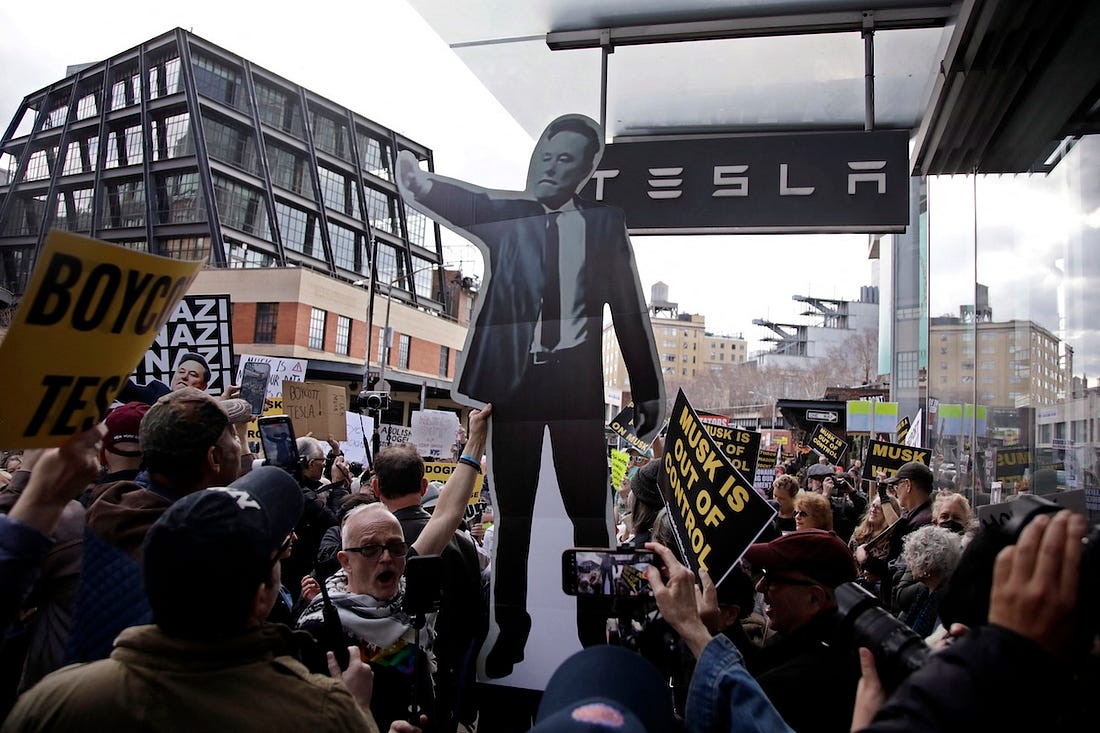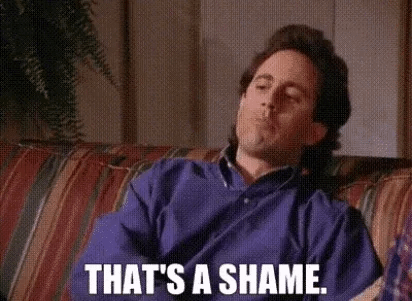|
 |
More Boycotts Please
Tesla Takedown is a great start, but taking down Tesla should be just that: a start.
One decent if unscientific way to gauge of the trajectory of the second Trump administration is to track the ratio of good and bad news over time. In the first days everything was terrible. Today, most things are still quite bad, but as Trump has over-reached and misgoverned himself into toxic unpopularity, there are many more hopeful signs: legal victories, Trump retreats, failed nominees. Things like that.
To my eye, the best development of the week—or at least the most schadenfreudacious¹—comes via Jonathan Gitlin of Ars Technica. With apologies to Jonathan for quoting at length:
Tesla is in deep trouble in Europe. The electric vehicle maker, which once dominated EV sales in the region, is facing sales declines of more than 50 percent in France, the Netherlands, Sweden, Denmark, and the UK. Sales in Germany weren't quite as bad—they fell by 46 percent in April, with slightly smaller decreases in Portugal and Spain. Only Italy and Norway saw any kind of sales growth….
The UK has been one of Tesla's biggest markets in Europe, and it's seeing something of an EV boom, with 8.1 percent more BEVs registered in April 2025 than the year before, even as overall car sales have dropped by 10.4 percent year on year. But Tesla's sales fell by 62 percent—the automaker registered just 512 cars all month. For context, 120,331 new cars were registered in the UK last month, of which 24,558 were BEVs….
In Germany, the overall car market fared much better, with new registrations decreasing by just 0.2 percent in April. Of those new cars, 45,535 were BEVs—a 53.5 percent increase year over year. In the context of those rising BEV sales, Tesla's 46 percent year on year decline should have alarm bells ringing.
Some other European countries are smaller markets for Tesla but have seen even more significant sales declines. In Sweden, Tesla sales dropped 81 percent. In the Netherlands, sales were down 73.8 percent. In Denmark, sales fell by 67 percent, and in France, they fell by 59 percent.
tl;dr, Tesla is in steep decline in the U.S., but in complete free fall in Europe, and not in the context of a larger automotive depression or even a slump in electric vehicle purchases. Tesla’s shrinking even as EV sales soar.
“With a claimed annual capacity of 375,000 vehicles,” Gitlin concludes. “Tesla's factory on the outskirts of Berlin seems likely to be underutilized for some time.”
This is as it should be—indeed the motive force here is so obvious, you’ve been reading for 10 paragraphs, knowing full-well what explains Tesla’s crisis, without me ever spelling it out. When Elon Musk tells Tesla shareholders that the company’s declining revenue is attributable in some measure to protesters who’ve received fraudulent government payments, they know he’s full of shit, and that he’s solely responsible.
But if Musk’s noxious politics and crimes against democracy were sparks, the Tesla Takedown movement was obviously a catalyst—a visible and communal reminder to a livid global public that Musk is vulnerable. If you own a Tesla, sell it; if you want or need an electric vehicle, buy from his competitors. Simple actions anyone can take.
It doesn’t detract from the grassroots organizers who turned Tesla Takedown into a global phenomenon that in this instance, the logic of the boycott was unusually straightforward. Musk was Donald Trump’s main campaign donor and top propagandist, then his main goon hired to pulverize the American government, and advocate far right politics throughout the democratic world. But he was only able to attain this power through wealth, and his wealth comes from his ownership of a car company. 1 + 2 = 3.
With this success close at hand, the time is ripe to extend the horizon of protests beyond “companies owned by Trump’s corrupt flunkies.” By all means, the Tesla boycott should continue until Musk is ruined. But we should also think through ways liberal economic power can be put to use, not just to punish complicit executives, but to make the Trump agenda harder to execute; even to force him to follow the law.
CULTURE SHOCK AND AWE
There were boycotts in the first Trump administration, including of Trump’s own businesses, from which he notoriously refused to divest. Those boycotts might have ruined Trump but for the fact that his businesses were easy conduits for bribery. Trump also didn’t sell products that were of particular interest to his political enemies, so he was more easily able to market them to supporters, and in the years since he has reoriented his business toward serving and swindling them.
But for the most part the boycott method in his first term stemmed from an indirect approach that came to be called “cancel culture,” which, whatever you want to say about it, did not typically operate the way Tesla Takedown operates.
Instead, it tended to work obliquely: People with some purchasing power, but much more cultural clout, would take aim, usually online, at individuals who’d transgressed—sometimes in obvious ways, sometimes in ambiguous ways—and drum them out of employment and public life. A boycott, of a sort. But the goal was to send broader signals to other individuals and institutions about where the center of cultural power lay, and obliquely served to discipline corporate actors who, fearful of losing market share in big progressive cities, would side with the broad left in its culture-war clashes against the right.
Roundabout as it seems in hindsight, and ripe for overreach as it was, I continue to have real sympathy for the impulse. The candidate for the left half of America had won the popular vote, but her party had lost all political power; cities were engines of the American economy, but suddenly found themselves both mooched upon and menaced politically by their own government. In a free society the left was obviously going to seek new outlets for wielding power, and that meant flexing economic and cultural might. In practice it often materialized in alliances with business to oppose various bigotries and attacks on civil rights.
Remember when Republicans went to war against “woke capital”? They were trying to build a backlash to this dynamic.
There were good and bad arguments against the approach, which I won’t rehash here, but it ultimately lost the day. I don’t think it’s a coincidence that “cancel culture” hasn’t re-emerged organically in Trump’s second term, and if it did, it would probably backfire.
But the boycott method’s failure when deployed in this circuitous fashion doesn’t discredit the boycott method altogether. Cancel culture was diffuse, symbolic, and culturally loaded. Direct boycotts are something else. The success of Tesla Takedown makes an implicit case for returning to old-fashioned collective action: using discernment to pick winnable fights with wittingly or unwittingly complicit companies.

